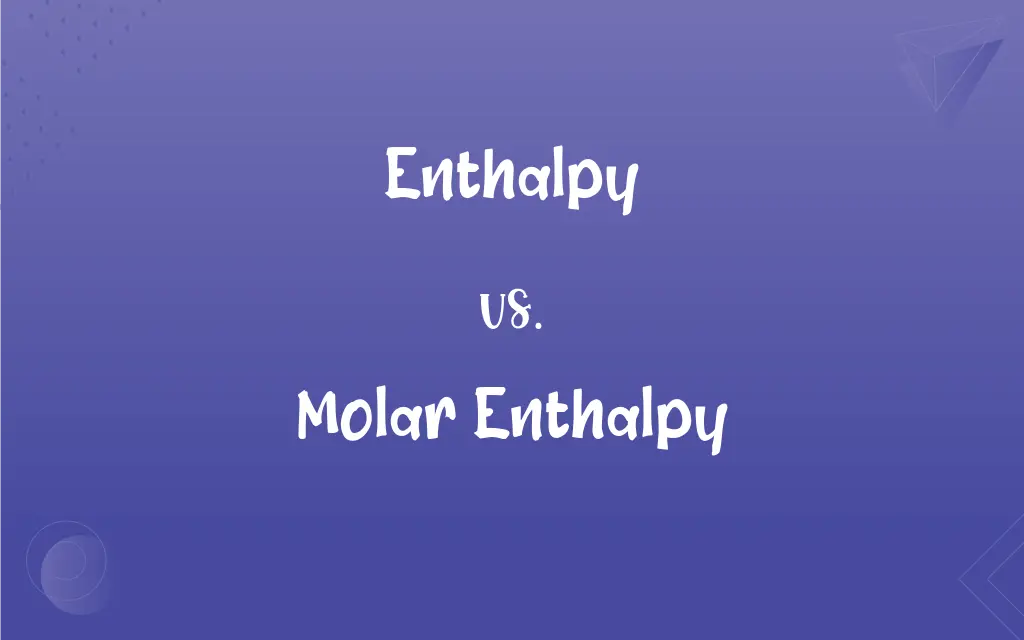Enthalpy vs. Molar Enthalpy: What's the Difference?
Edited by Aimie Carlson || By Janet White || Published on December 20, 2023
Enthalpy is total heat content of a system. Molar Enthalpy is heat content per mole of a substance.

Key Differences
Enthalpy is a thermodynamic property representing the total heat content of a system, encompassing internal energy plus the product of pressure and volume. Molar enthalpy specifically refers to enthalpy per mole of a substance, making it a measure of the heat content on a per-mole basis.
In practical applications, enthalpy is used to calculate the heat change in chemical reactions and physical changes. Molar enthalpy, however, provides a more specific measure, indicating the heat change associated with one mole of a substance, which is crucial in stoichiometric calculations in chemistry.
Enthalpy changes can be measured during various processes, like evaporation, condensation, and chemical reactions. Molar enthalpy is particularly useful in understanding these changes for specific amounts of substances, aiding in the precise calculation of heats of reaction.
In thermodynamics, enthalpy is a key concept for analyzing energy transfer in heat form. Molar enthalpy is vital in the context of chemical reactions, especially in determining the energy profiles of reactants and products.
Enthalpy is a macroscopic property, relevant in a wide range of fields from engineering to meteorology. Molar enthalpy is more specific to chemistry and is essential for understanding the energetic aspects of chemical substances on a molecular level.
ADVERTISEMENT
Comparison Chart
Definition
Total heat content of a system
Heat content per mole of a substance
Measurement
In joules (J) or calories
In joules per mole (J/mol) or calories per mole
Relevance
General thermodynamic processes
Stoichiometric calculations in chemistry
Scale
Applies to entire systems
Specific to individual substances
Use
Broad, across various disciplines
More specific to chemical reactions
ADVERTISEMENT
Enthalpy and Molar Enthalpy Definitions
Enthalpy
Heat content of a system at constant pressure.
The enthalpy change in the reaction was significant, indicating high energy release.
Molar Enthalpy
Specific enthalpy change for one mole.
The molar enthalpy of fusion is vital in understanding melting processes.
Enthalpy
A measure of heat under constant pressure.
In the process, the enthalpy increased, showing heat absorption.
Molar Enthalpy
Enthalpy change per mole of a substance.
The molar enthalpy of reaction provides insight into the energetics of the process.
Enthalpy
Total energy of a thermodynamic system.
Enthalpy includes both internal energy and the work done by the system.
Molar Enthalpy
Heat content of one mole of a substance.
Molar enthalpy is used to calculate the energy involved in chemical reactions.
Enthalpy
Energy change in chemical reactions at constant pressure.
The enthalpy of combustion is a critical parameter for fuels.
Molar Enthalpy
Enthalpy per mole, important in stoichiometry.
Knowing the molar enthalpy helps predict the outcome of a chemical reaction.
Enthalpy
Represents heat absorption or release in a system.
The enthalpy change of vaporization indicates the energy needed to vaporize a liquid.
Molar Enthalpy
Measure of heat change for a mole of a reactant or product.
Molar enthalpy changes are essential for balancing chemical equations.
Enthalpy
Symbol H A thermodynamic function of a system, equivalent to the sum of the internal energy of the system plus the product of its volume multiplied by the pressure exerted on it by its surroundings.
Enthalpy
A measure of the heat content of a chemical or physical system.
, where H is enthalpy, U is internal energy, p is pressure, and V is volume.
Enthalpy
(thermodynamics) a thermodynamic quantity equal to the internal energy of a system plus the product of its volume and pressure;
Enthalpy is the amount of energy in a system capable of doing mechanical work
FAQs
What is enthalpy?
Enthalpy is the total heat content of a system, including internal energy and pressure-volume work.
Can enthalpy be negative?
Yes, enthalpy can be negative, indicating heat release from the system.
What does a negative molar enthalpy indicate?
A negative molar enthalpy indicates that a reaction releases heat per mole of a substance.
How is enthalpy measured?
Enthalpy is typically measured in joules (J) or calories.
What is the difference between enthalpy and internal energy?
Enthalpy includes internal energy and the product of pressure and volume, while internal energy is just one component.
What does molar enthalpy mean?
Molar enthalpy refers to the enthalpy change per mole of a substance.
What role does molar enthalpy play in calorimetry?
Molar enthalpy is essential in calorimetry to determine the heat exchange per mole in a reaction.
What units are used for molar enthalpy?
Molar enthalpy is measured in joules per mole (J/mol) or calories per mole.
Why is enthalpy important in thermodynamics?
Enthalpy is crucial for analyzing heat transfer and energy changes in thermodynamic processes.
Is enthalpy a state function?
Yes, enthalpy is a state function, depending only on the state of the system.
Can molar enthalpy change with temperature?
Yes, molar enthalpy can vary with temperature changes.
Is enthalpy measurable directly?
Enthalpy cannot be measured directly; it is calculated from measurable quantities like temperature and pressure.
How do you calculate enthalpy change?
Enthalpy change is calculated using the heat transfer at constant pressure or from changes in internal energy and volume.
Why is molar enthalpy important in stoichiometry?
Molar enthalpy is crucial in stoichiometry for calculating the energy involved in reactions per mole of reactants or products.
How does molar enthalpy assist in predicting reaction outcomes?
Molar enthalpy helps predict whether a reaction will be exothermic or endothermic, influencing reaction conditions and products.
Can enthalpy be used to determine reaction spontaneity?
Enthalpy alone cannot determine reaction spontaneity; it must be combined with entropy considerations.
Is molar enthalpy different for different substances?
Yes, molar enthalpy varies between substances based on their molecular structure and bonding.
In what scenarios is molar enthalpy used?
Molar enthalpy is used in chemistry, especially in stoichiometric calculations and understanding reaction energetics.
Does phase change affect enthalpy?
Yes, phase changes like melting or vaporization significantly affect the enthalpy of a system.
How is molar enthalpy related to chemical reactions?
Molar enthalpy helps quantify the energy change per mole in chemical reactions.
About Author
Written by
Janet WhiteJanet White has been an esteemed writer and blogger for Difference Wiki. Holding a Master's degree in Science and Medical Journalism from the prestigious Boston University, she has consistently demonstrated her expertise and passion for her field. When she's not immersed in her work, Janet relishes her time exercising, delving into a good book, and cherishing moments with friends and family.
Edited by
Aimie CarlsonAimie Carlson, holding a master's degree in English literature, is a fervent English language enthusiast. She lends her writing talents to Difference Wiki, a prominent website that specializes in comparisons, offering readers insightful analyses that both captivate and inform.







































































